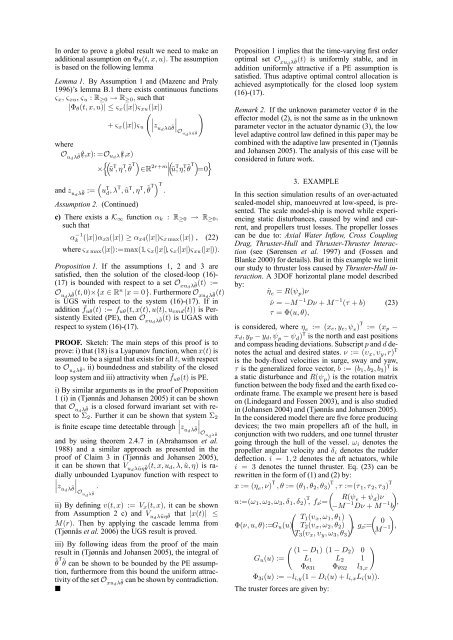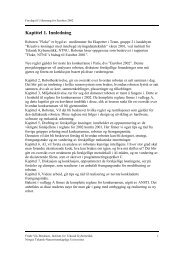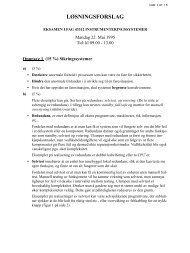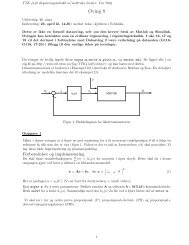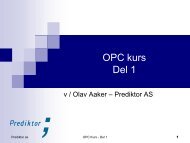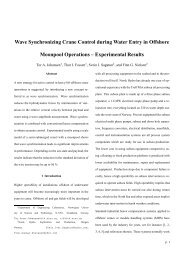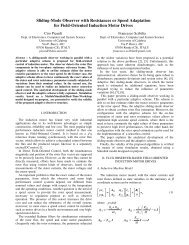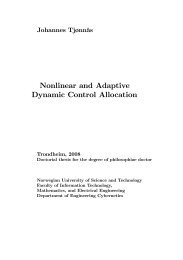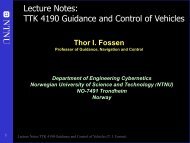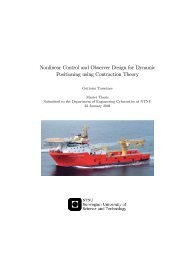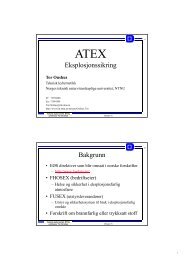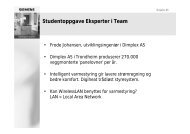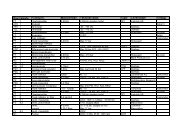ON OPTIMIZING NONLINEAR ADAPTIVE CONTROL ... - NTNU
ON OPTIMIZING NONLINEAR ADAPTIVE CONTROL ... - NTNU
ON OPTIMIZING NONLINEAR ADAPTIVE CONTROL ... - NTNU
You also want an ePaper? Increase the reach of your titles
YUMPU automatically turns print PDFs into web optimized ePapers that Google loves.
In order to prove a global result we need to make an<br />
additional assumption on (t; x; u): The assumption<br />
is based on the following lemma<br />
Lemma 1. By Assumption 1 and (Mazenc and Praly<br />
1996)'s lemma B.1 there exists continuous functions<br />
& x ; & xu , & u : R 0 ! R 0 ; such that<br />
j (t; x; u)j & x (jxj)& xu (jxj)<br />
!<br />
zud <br />
+ & x (jxj)& u ~u ~<br />
<br />
Oud<br />
~u ~ <br />
where<br />
O ud ~ (t;x): =O u d (t;x)<br />
<br />
n~u T ; T ; ~ T <br />
2R 2r+m <br />
~u T ; T ; ~ T o<br />
=0<br />
and z ud ~ := u T d ; T ; ~u T ; T ; ~ T T<br />
:<br />
Assumption 2. (Continued)<br />
c) There exists a K 1 function k : R 0 ! R 0 ;<br />
such that<br />
1<br />
k (jxj) x3(jxj) x4 (jxj)& x max (jxj) , (22)<br />
where & x max (jxj):=max(1; & x (jxj); & x (jxj)& xu (jxj)):<br />
Proposition 1. If the assumptions 1, 2 and 3 are<br />
satised, then the solution of the closed-loop (16)-<br />
(17) is bounded with respect to a set O xud ~ (t) :=<br />
O ud ~ (t; 0)fx 2 Rn jx = 0g: Furthermore O xud ~ (t)<br />
is UGS with respect to the system (16)-(17): If in<br />
addition f u (t) := f u (t; x(t); u(t); u cmd (t)) is Persistently<br />
Exited (PE), then O xud ~ (t) is UGAS with<br />
respect to system (16)-(17).<br />
PROOF. Sketch: The main steps of this proof is to<br />
prove: i) that (18) is a Lyapunov function, when x(t) is<br />
assumed to be a signal that exists for all t; with respect<br />
to O ud ~ ; ii) boundedness and stability of the closed<br />
loop system and iii) attractivity when f u (t) is PE.<br />
i) By similar arguments as in the proof of Proposition<br />
1 (i) in (Tjønnås and Johansen 2005) it can be shown<br />
that O ud ~ is a closed forward invariant set with respect<br />
to 2 : Further it can be shown that system 2<br />
<br />
is nite escape time detectable through z ud ~<br />
<br />
Oud<br />
~ <br />
and by using theorem 2.4.7 in (Abrahamson et al.<br />
1988) and a similar approach as presented in the<br />
proof of Claim 3 in (Tjønnås and Johansen 2005),<br />
it can be shown that V ud ~u ~ (t; x; u d; ; ~u; ) is radially<br />
unbounded Lyapunov function with respect to<br />
<br />
z ud ~ :<br />
<br />
Oud<br />
~ <br />
ii) By dening v(t; x) := V x (t; x); it can be shown<br />
from Assumption 2 c) and V ud ~u ~ that jx(t)j <br />
M(r): Then by applying the cascade lemma from<br />
(Tjønnås et al. 2006) the UGS result is proved.<br />
iii) By following ideas from the proof of the main<br />
result in (Tjønnås and Johansen 2005), the integral of<br />
~ T ~ can be shown to be bounded by the PE assumption,<br />
furthermore from this bound the uniform attractivity<br />
of the set O xud ~ can be shown by contradiction.<br />
<br />
Proposition 1 implies that the time-varying rst order<br />
optimal set O xud ~ (t) is uniformly stable, and in<br />
addition uniformly attractive if a PE assumption is<br />
satised. Thus adaptive optimal control allocation is<br />
achieved asymptotically for the closed loop system<br />
(16)-(17).<br />
Remark 2. If the unknown parameter vector in the<br />
effector model (2), is not the same as in the unknown<br />
parameter vector in the actuator dynamic (3), the low<br />
level adaptive control law dened in this paper may be<br />
combined with the adaptive law presented in (Tjønnås<br />
and Johansen 2005). The analysis of this case will be<br />
considered in future work.<br />
3. EXAMPLE<br />
In this section simulation results of an over-actuated<br />
scaled-model ship, manoeuvred at low-speed, is presented.<br />
The scale model-ship is moved while experiencing<br />
static disturbances, caused by wind and current,<br />
and propellers trust losses. The propeller losses<br />
can be due to: Axial Water Inow, Cross Coupling<br />
Drag, Thruster-Hull and Thruster-Thruster Interaction<br />
(see (Sørensen et al. 1997) and (Fossen and<br />
Blanke 2000) for details). But in this example we limit<br />
our study to thruster loss caused by Thruster-Hull interaction.<br />
A 3DOF horizontal plane model described<br />
by:<br />
_ e = R( p )<br />
_ = M 1 D + M 1 ( + b) (23)<br />
= (u; );<br />
is considered, where e := (x e ; y e ; e ) T := (x p<br />
x d ; y p y d ; p d ) T is the north and east positions<br />
and compass heading deviations. Subscript p and d denotes<br />
the actual and desired states. := ( x ; y ; r) T<br />
is the body-xed velocities in surge, sway and yaw,<br />
is the generalized force vector, b := (b 1 ; b 2 ; b 3 ) T is<br />
a static disturbance and R( p ) is the rotation matrix<br />
function between the body xed and the earth xed coordinate<br />
frame. The example we present here is based<br />
on (Lindegaard and Fossen 2003), and is also studied<br />
in (Johansen 2004) and (Tjønnås and Johansen 2005).<br />
In the considered model there are ve force producing<br />
devices; the two main propellers aft of the hull, in<br />
conjunction with two rudders, and one tunnel thruster<br />
going through the hull of the vessel. ! i denotes the<br />
propeller angular velocity and i denotes the rudder<br />
deection. i = 1; 2 denotes the aft actuators, while<br />
i = 3 denotes the tunnel thruster. Eq. (23) can be<br />
rewritten in the form of (1) and (2) by:<br />
x := ( e ; ) T ; := ( 1 ; 2 ; 3 ) T ; :=( 1 ; 2 ; 3 ) T<br />
<br />
u:=(! 1 ; ! 2 ; ! 3 ; 1 ; 2 ) T R(<br />
; f x :=<br />
e + d )<br />
;<br />
(; u; ):=G u (u)<br />
T 1 ( x ; ! 1 ; 1 )<br />
T 2 ( x ; ! 2 ; 2 )<br />
T 3 ( x ; y ; ! 3 ; 3 )<br />
M 1 D + M 1 b<br />
! 0<br />
; g x :=<br />
M 1 ;<br />
!<br />
(1 D 1 ) (1 D 2 ) 0<br />
G u (u) := L 1 L 2 1<br />
31 32 l 3;x<br />
3i (u) := l i;y (1 D i (u) + l i;x L i (u)):<br />
The truster forces are given by:


